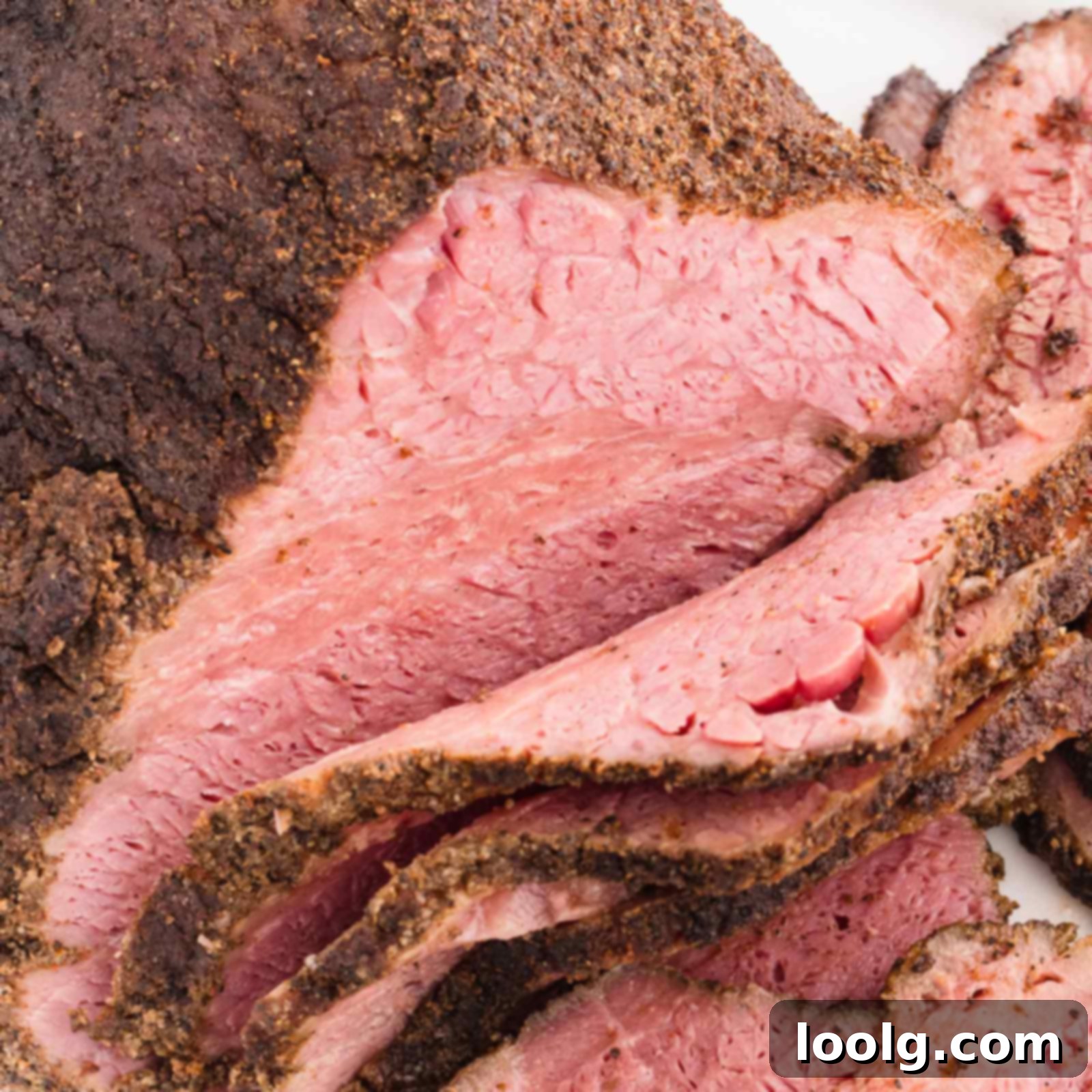The Ultimate Guide to Smoking Corned Beef Brisket: Achieve Tender, Flavorful Perfection
Embark on a culinary adventure with this incredibly simple yet profoundly flavorful smoked corned beef brisket recipe. Unlike traditional boiling methods, smoking the brisket infuses it with an irresistible depth of flavor and a tender, juicy texture that will redefine your appreciation for corned beef. This naturally dairy-free and gluten-free dish is a fantastic option for various dietary needs, making it a crowd-pleaser for any occasion. This article, along with its accompanying photos and recipe details, was thoughtfully updated in February 2025 to provide you with the most comprehensive and helpful guide possible.
We understand that visual appeal is just as important as taste. Previously, some of the recipe photos, unfortunately, depicted the brisket incorrectly sliced, which was a source of frustration. Rest assured, these images have been meticulously updated to accurately represent the beautiful results you can achieve. Furthermore, we’ve taken the opportunity to enhance the post with even more valuable tips and information, ensuring your smoking experience is seamless and successful.
In our quest for perfection, we’ve also introduced a slightly more traditional spice rub option. The original rub, beloved for its robust character, featured black pepper, garlic powder, onion powder, paprika, and a hint of cayenne for a subtle kick. The new, more traditional variation, however, thoughtfully omits the cayenne, incorporating fragrant ground coriander and zesty ground mustard seeds to deliver a classic profile. While both versions are exceptional, I personally lean towards the original for its unique warmth. To cater to every palate, both delightful spice rub options are conveniently listed in the recipe box below.
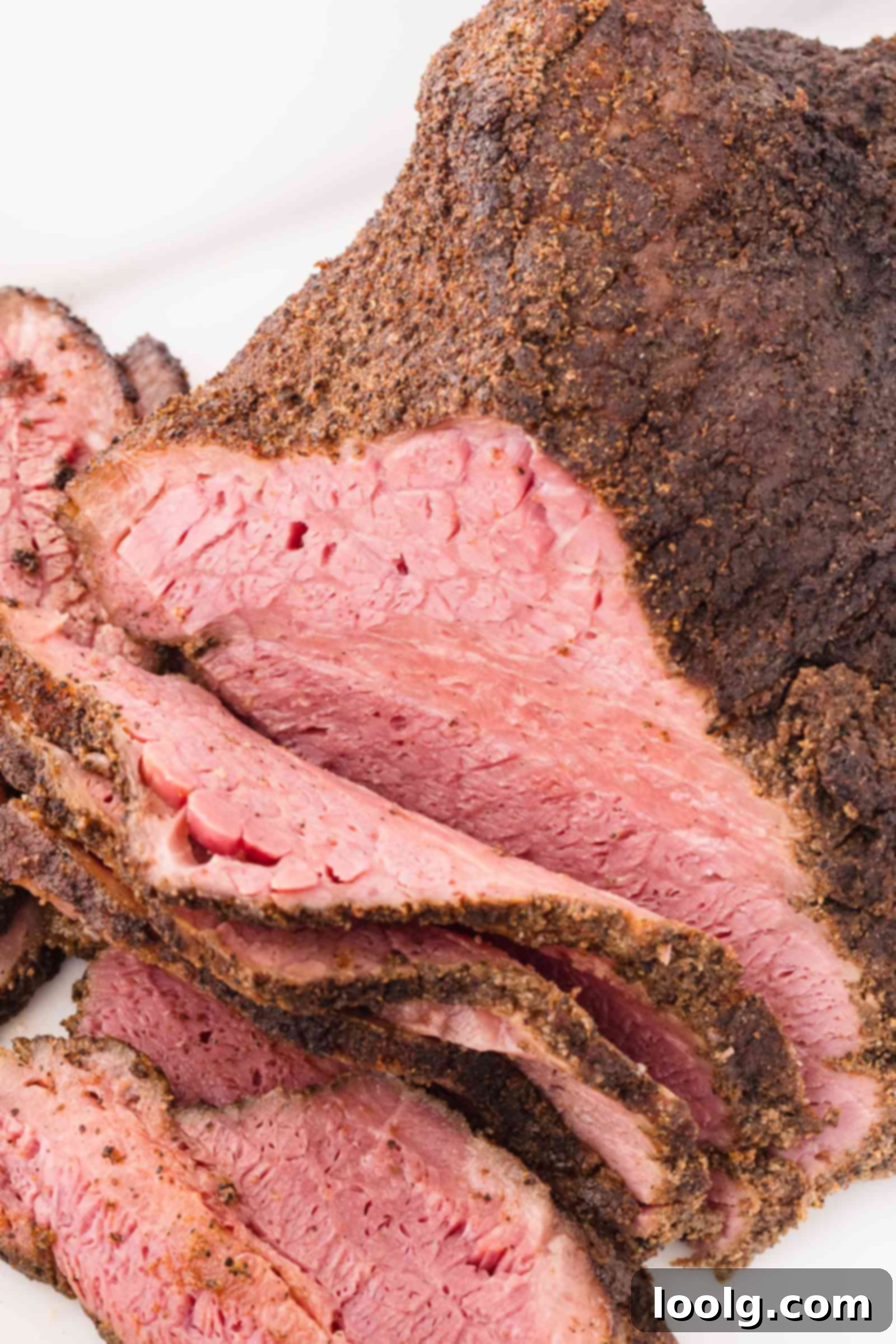
What Makes This Smoked Corned Beef Brisket Irresistible?
- This smoked corned beef brisket boasts a bold, smoky flavor that elevates the classic salt-cured taste to new heights, making it truly unforgettable.
- Easy preparation using straightforward ingredients and techniques ensures this recipe is accessible and perfect for home cooks of all skill levels.
- The result is consistently tender, incredibly juicy, and richly packed with aromatic spices, making it versatile for sandwiches, a hearty hash, or simply enjoying on its own as a show-stopping main course.
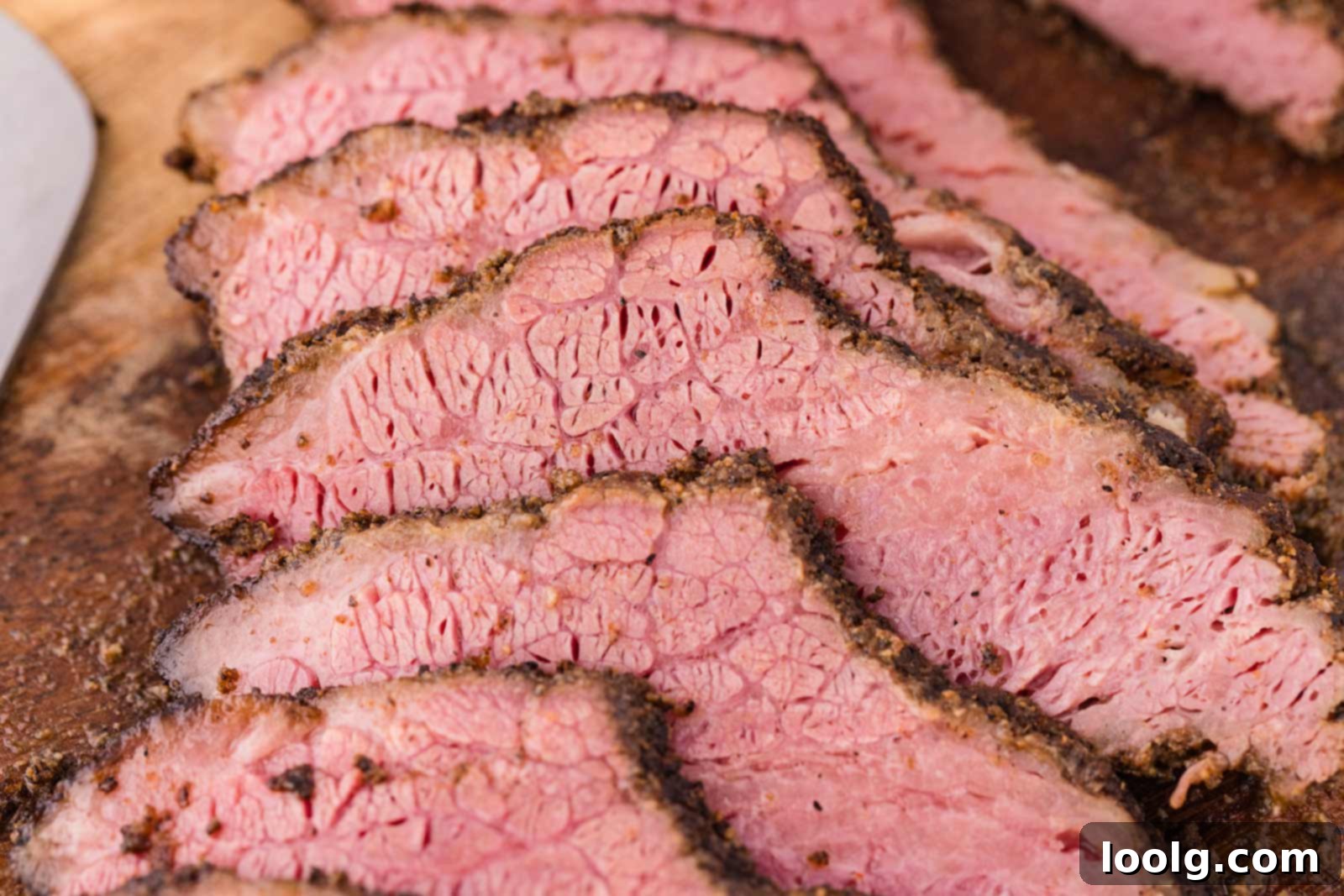
Understanding Corned Beef: History, Curing, and Flavor Profile
Corned beef is a true culinary staple, renowned for its distinctive taste and texture. But what exactly is it, and where does the intriguing term “corned” come from? Essentially, corned beef refers to beef brisket that has been salt-cured and seasoned. The term “corned” doesn’t relate to corn kernels at all, but rather to the “corns” or large rock salt crystals traditionally used in the curing process. These salt crystals were historically similar in size to corn kernels, hence the name.
The curing process involves brining the brisket in a solution of salt, sugar, and various spices like bay leaves, peppercorns, and allspice. This process not only preserves the meat but also imparts its characteristic salty and tangy flavor while tenderizing the tough brisket fibers. Traditionally, corned beef is simmered for hours until it’s fork-tender, often served with cabbage and potatoes, especially during celebrations like St. Patrick’s Day. However, our smoked corned beef recipe takes this classic dish to an entirely new dimension. By introducing it to the low and slow heat of a smoker, we infuse it with a deep, rich, and complex smoky flavor that beautifully complements the savory spices, creating a perfect balance that’s simply impossible to achieve with conventional boiling. The smoke adds an earthy, robust layer that transforms the familiar into something extraordinary.
How to Choose the Perfect Corned Beef for Smoking
Selecting the right cut of corned beef brisket is crucial for achieving the best results with your smoker. A brisket is comprised of two distinct muscles: the flat cut and the point cut. For smoking, you’ll typically purchase a pre-brined corned beef brisket, which is usually either the flat or the point, or sometimes a combination if it’s a smaller “packer” cut. Avoid buying a whole, unbrined brisket and brining it yourself unless you are experienced and have ample time, as it requires a significant time commitment.
Understanding the differences between the flat and point cuts will help you make an informed decision based on your preference:
Flat Cut (First Cut)
- Appearance: This is the leaner, more uniform, and distinctly rectangular section of the brisket. It’s often preferred for its clean presentation.
- Fat Content: The flat cut has significantly less internal marbling and generally features a thinner, more consistent fat layer on one side. This makes it a great choice for those who prefer leaner meat.
- Texture: Due to its lower fat content, the flat cut can be slightly firmer than the point. However, when properly smoked low and slow, it still achieves remarkable tenderness, perfect for slicing.
- Use: Its uniform shape and leaner profile make it ideal for slicing against the grain into beautiful, consistent pieces, which are perfect for classic corned beef sandwiches, hash, or as a main dish.
- Cooking Characteristics: It tends to cook more evenly because of its consistent thickness, requiring less monitoring for hot spots.
Point Cut (Second Cut)
- Appearance: The point cut is thicker, more irregular, and typically triangular in shape, with a more varied texture.
- Fat Content: This cut is highly marbled with intramuscular fat and boasts a much thicker fat cap. This generous fat content is a major contributor to its rich flavor and succulent texture.
- Texture: Thanks to its higher fat content, the point cut is inherently more tender, juicier, and more forgiving during the smoking process, often melting in your mouth.
- Use: It’s the preferred choice for making legendary burnt ends, shredded pulled beef, or for those who simply crave a richer, more intensely flavored corned beef experience.
- Cooking Characteristics: Its irregular shape can make even cooking slightly more challenging, but the ample fat protects the meat and yields incredible flavor and tenderness when cooked patiently at a low temperature.
If your goal is to achieve cleaner, more uniform slices of leaner corned beef, the flat cut is your best bet. If you prioritize maximum moisture, richer flavor, and that melt-in-your-mouth tenderness, often with a slightly more rustic presentation, then the point cut will not disappoint. Both cuts, when smoked correctly, will yield a spectacular dish, so choose according to your desired outcome.
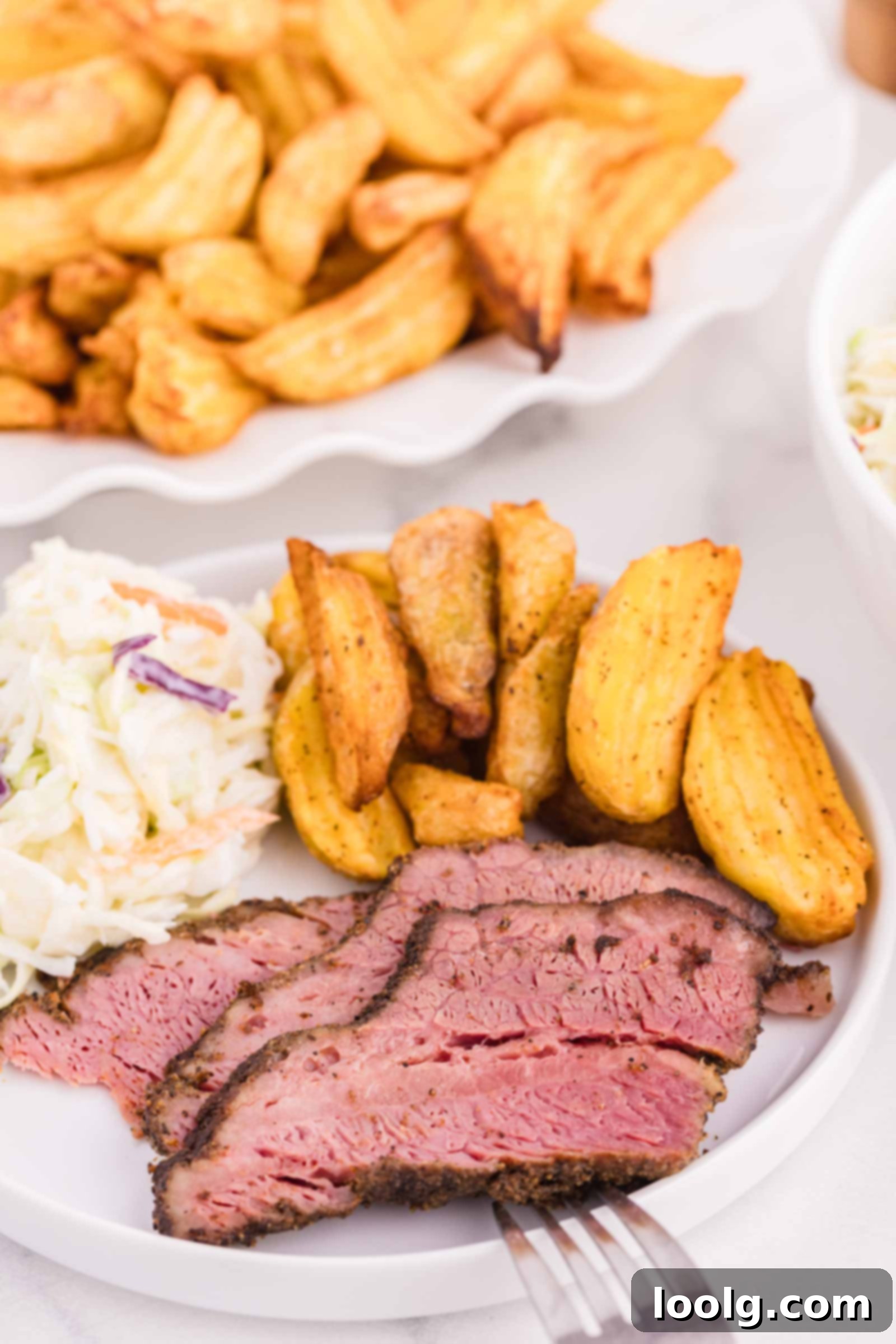
Selecting Your Smoking Wood: Enhancing Flavor
The type of wood you choose for smoking significantly influences the final flavor profile of your corned beef brisket. Each wood variety imparts its own unique aroma and taste, allowing you to customize your dish to your preference. For this particular corned beef recipe, I used hickory, which delivered a robust and classic smoky punch. However, don’s hesitate to experiment with other options:
- Hickory: A time-honored choice for smoking, hickory produces a strong, pronounced smoky flavor that beautifully complements the rich and savory taste of corned beef. It’s a consistently excellent option for brisket and other red meats, creating a quintessential barbecue aroma.
- Oak: Another powerful hardwood, oak offers a medium to strong smoky flavor that is slightly less intense than hickory but still provides a wonderful depth and earthy character to the meat. It’s a versatile wood that pairs well with most beef cuts.
- Cherry: If you’re looking for a fruitier, milder smoke, cherry wood is an excellent choice. It imparts a delicate, sweet, and subtle fruit flavor that can beautifully balance the savory spices of the corned beef, adding a touch of elegance to the dish.
- Apple: Similar to cherry, apple wood generates a mild, slightly sweet, and fruity smoke. This gentle flavor profile harmonizes wonderfully with the spices used in corned beef, making it a great option if you prefer a less aggressive smoke flavor that doesn’t overpower the meat.
- Pecan: Pecan wood provides a rich, nutty, and slightly sweet flavor that is reminiscent of hickory but generally milder. It can introduce a distinctive and incredibly tasty dimension to your smoked corned beef, offering a sophisticated twist.
- Maple: For a light and distinctively sweet smoke, maple wood is ideal. Its subtle sweetness can perfectly enhance the natural flavors of the corned beef and the spice rub without dominating them, resulting in a beautifully nuanced smoked profile.
No matter which wood you choose, remember to soak your wood chips in water for at least an hour before placing them in the smoker. This prevents them from igniting too quickly and helps them produce a steady, even smoke for a longer period, ensuring maximum flavor infusion.
The Crucial Step: Why Soaking Your Corned Beef is Essential
If you’re purchasing a pre-packaged corned beef brisket from the store (as opposed to brining your own from scratch), it will be very salty. This intense saltiness is a result of the curing process designed to preserve the meat. While some individuals might enjoy this high level of salt, for most, it will be overwhelmingly salty and detract from the overall flavor experience. This is why soaking the meat before smoking is a absolutely critical step for achieving a balanced and delicious outcome.
Soaking the corned beef in water helps to draw out a significant amount of the excess salt from the meat through osmosis. This process allows you to control the final saltiness to your liking, ensuring the smoky and spicy notes of your rub can truly shine. If you omit this step, even the most expertly smoked brisket will likely taste like a salt block.
For those new to smoking corned beef or for anyone who prefers a standard, enjoyable level of saltiness, it’s highly recommended to soak the brisket for 2-3 hours. During this period, it’s essential to change the water hourly. This ensures that the water doesn’t become saturated with salt, allowing the meat to continuously release more. For an even greater reduction in saltiness, you can extend the soaking time up to 24 hours, changing the water every few hours. This simple preparation step makes all the difference in transforming an overly salty piece of meat into a perfectly seasoned, tender, and incredibly flavorful smoked delicacy.
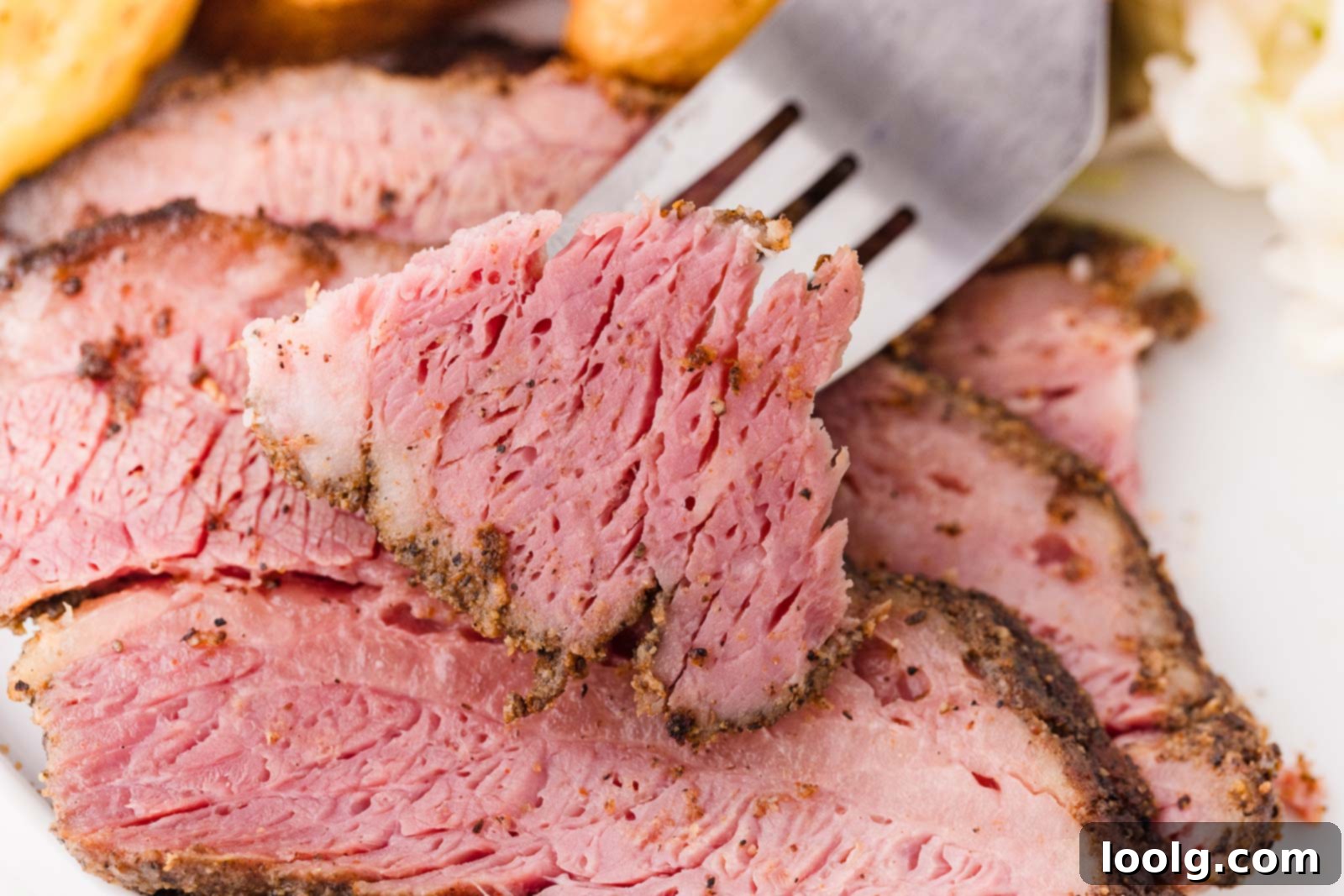
Mastering the Art of Preparing and Smoking Your Corned Beef Brisket
Once your corned beef has completed its essential desalting soak, the real magic begins. Remove the brisket from the soaking water, give it a thorough rinse under cool running water to wash off any residual salt, and then pat it completely dry with paper towels. A dry surface is key to forming a desirable “bark” during smoking. While the smoker preheats to a steady 275 °F (135 °C), prepare your chosen spice rub by mixing all the ingredients in a small bowl.
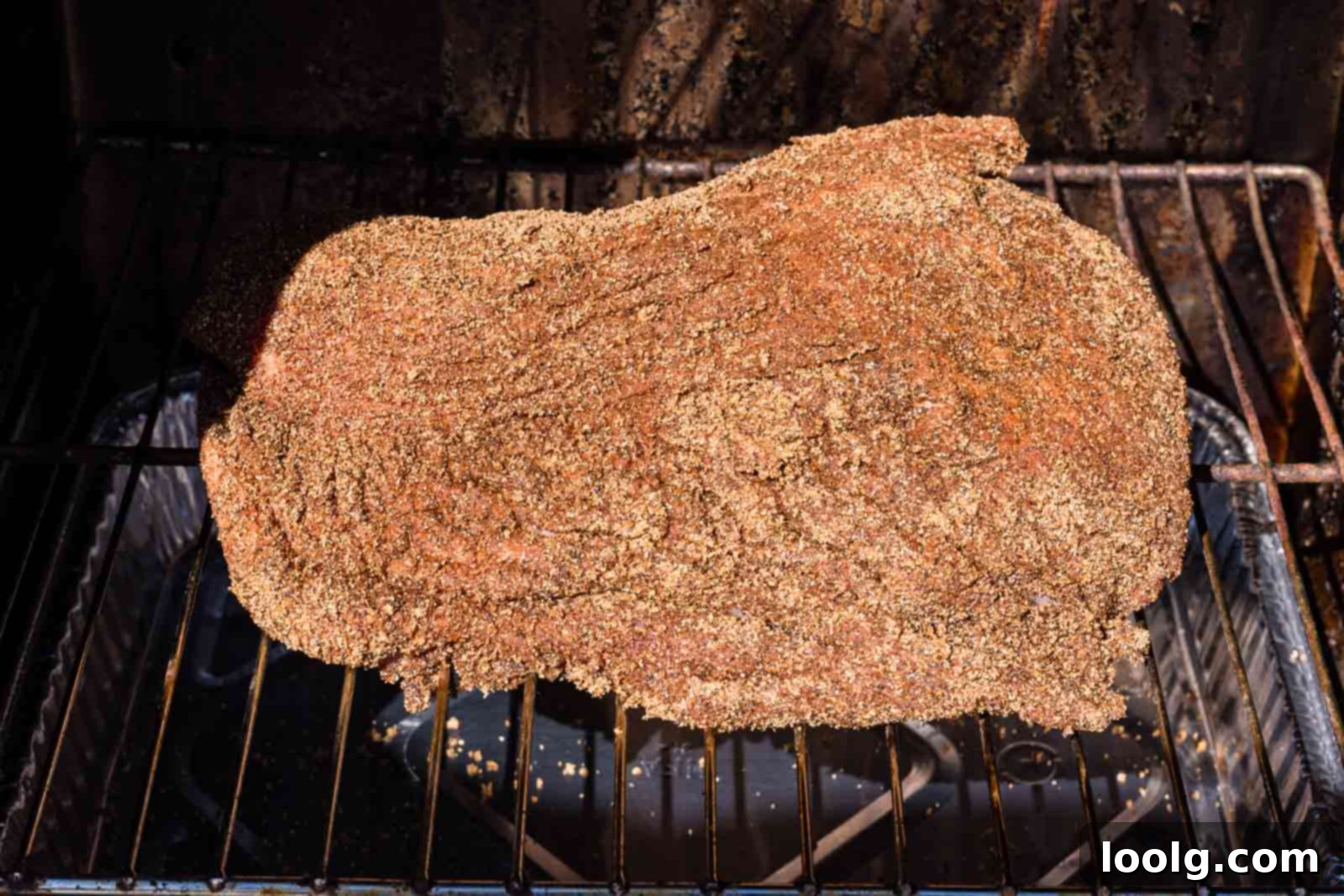
Brisket, by nature, is a cut of meat rich in strong muscle fibers and connective tissue, which makes it inherently tough if not cooked correctly. This is precisely why the low and slow method of smoking is so transformative. It allows the collagen within the meat to slowly break down into gelatin, resulting in that unbelievably tender and juicy texture we crave. Ensure you trim any excessive, hard fat, but leave a decent fat cap (about 1/4 to 1/2 inch) as it helps keep the brisket moist and flavorful throughout the long smoking process.
Liberally apply your chosen spice rub over every surface of the brisket, pressing it gently to ensure it adheres well. Once your smoker is at the target temperature and producing clean, blue smoke (not thick white smoke), carefully place the seasoned corned beef brisket directly onto the smoker grates. Maintain a consistent smoker temperature for the best results.
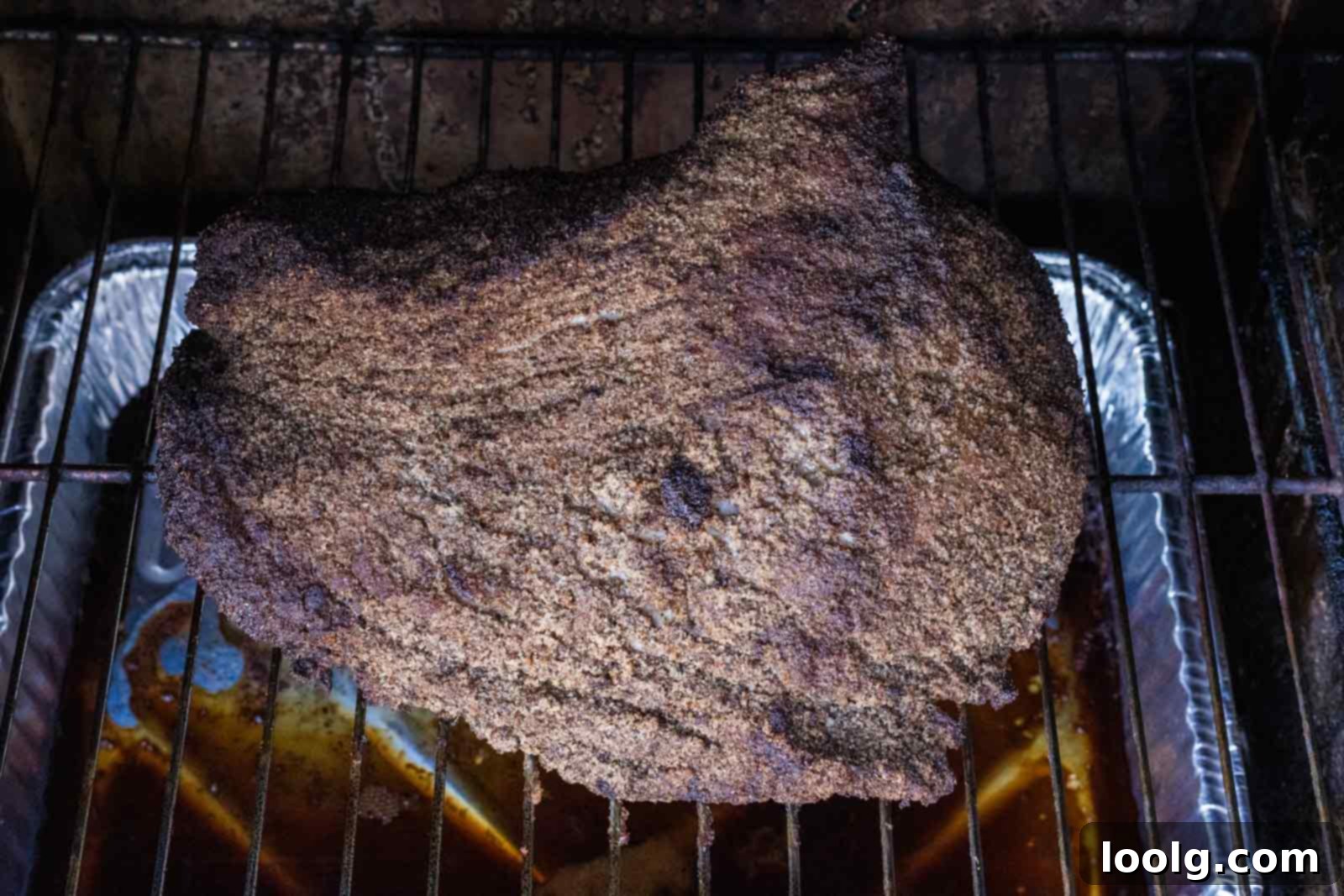
The initial smoking phase should continue until the internal temperature of the brisket reaches approximately 160 °F (71 °C). This typically takes about 2 to 3 hours, depending on the size and thickness of your brisket and the consistency of your smoker’s temperature. During this phase, the meat absorbs most of its smoky flavor and begins to develop that delicious bark.
However, reaching 160 °F (71 °C) is just the first milestone. For true tenderness, you’ll employ the “Texas Crutch” method. Carefully remove the brisket from the smoker and wrap it tightly in a double layer of heavy-duty aluminum foil. This wrapping technique helps to push the brisket through the “stall” (a period where the internal temperature plateaus) and creates a steamy environment that tenderizes the meat further without drying it out. Return the foil-wrapped brisket to the smoker and continue cooking until it reaches a final internal temperature of 200-205 °F (93-96 °C). This second phase will usually take another 2 to 3 hours, again varying with the brisket’s size.
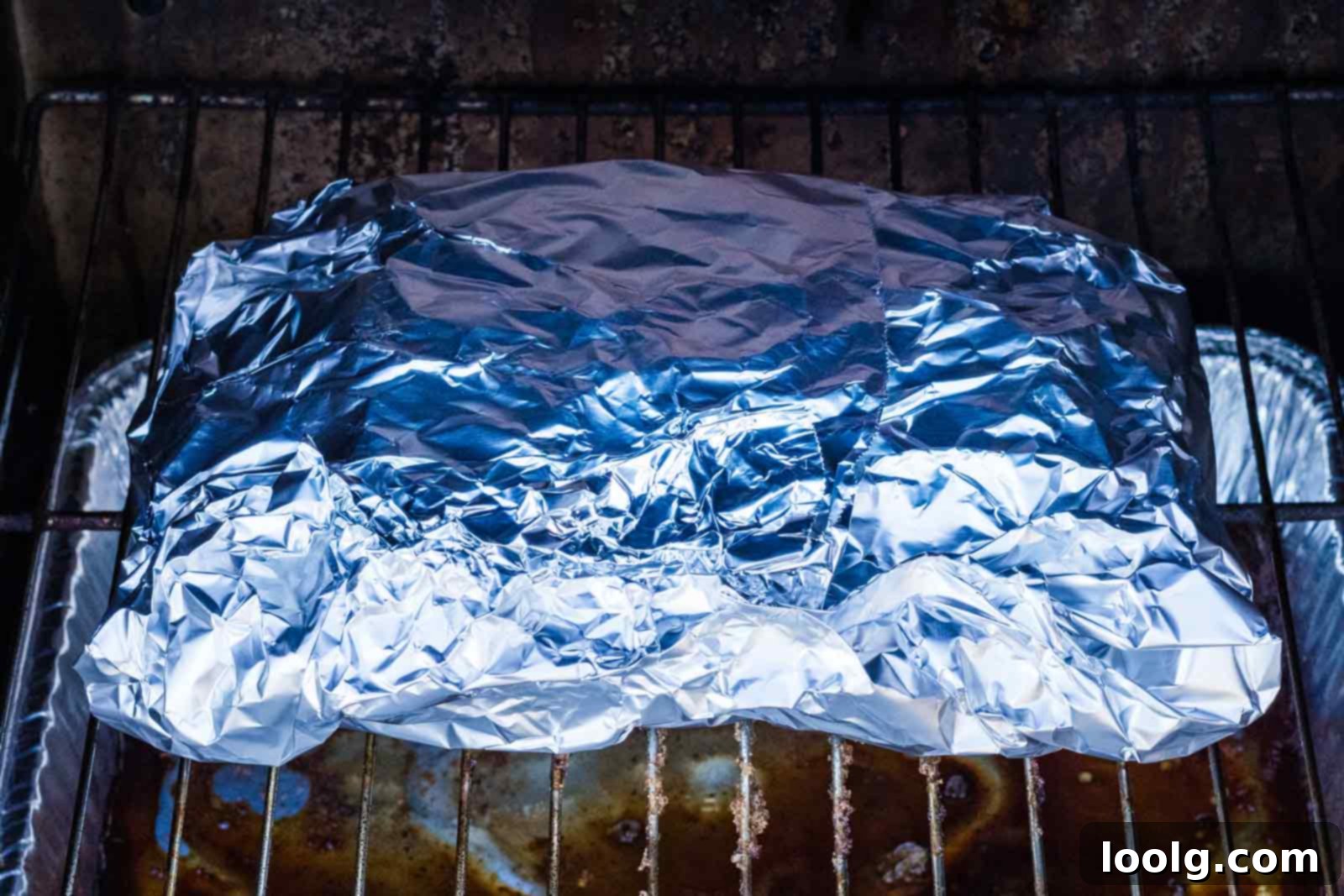
Once the brisket hits its target temperature, remove it from the smoker, still wrapped in its foil. It is absolutely crucial to let the meat rest. Allow it to rest for a minimum of 30 minutes, and ideally up to 2 hours. This resting period allows the muscle fibers to relax and reabsorb the juices, ensuring a supremely moist and tender brisket. Cutting into the meat too soon will cause all those precious juices to run out, leaving you with dry meat. It is always best to slice the corned beef just before serving to maintain its optimal moisture and warmth.
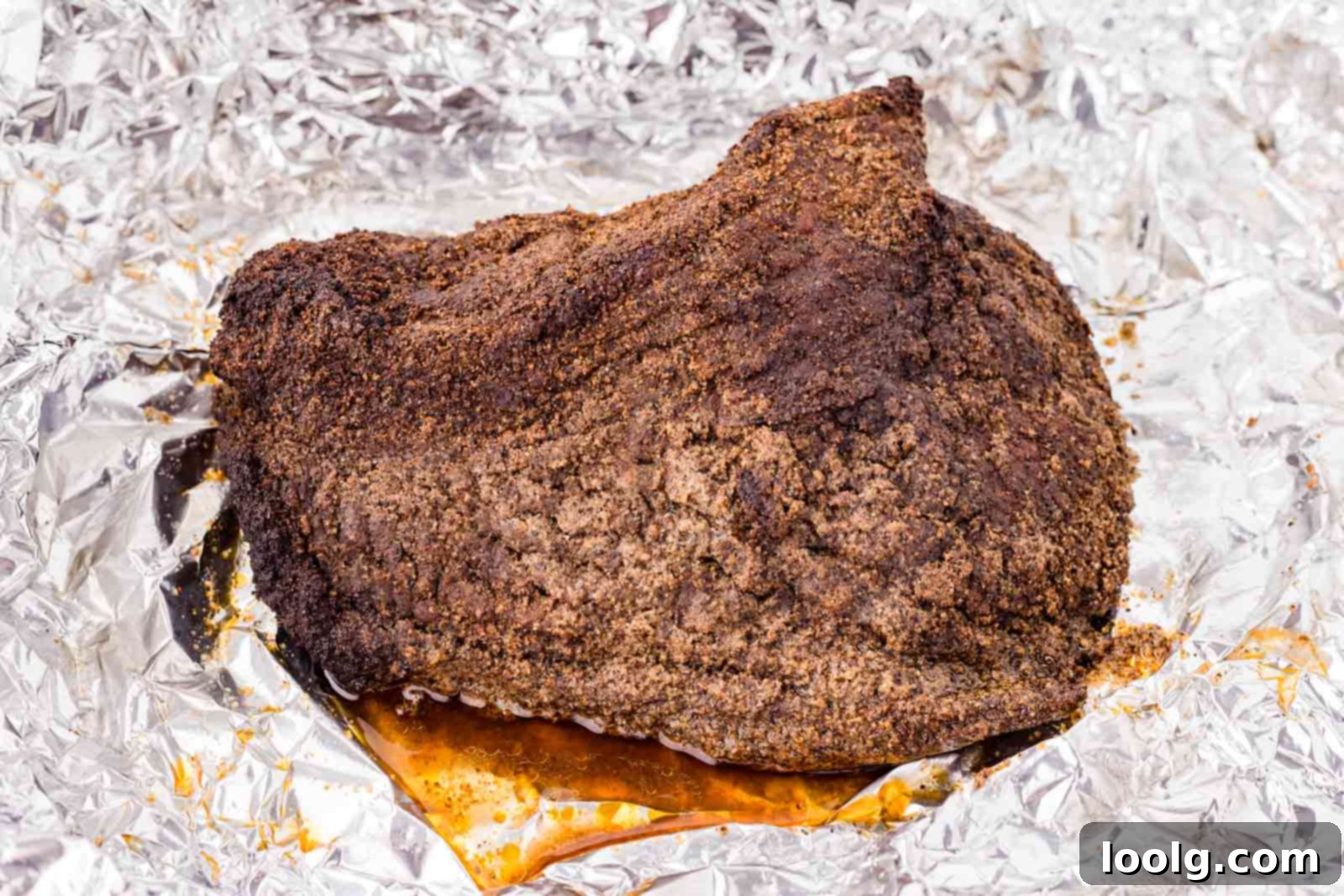
Beyond the smoking process itself, knowing how to properly slice your corned beef brisket is equally vital for a delightful eating experience. Incorrect slicing can turn even the most perfectly cooked brisket tough and chewy.
The Art of Slicing Smoked Corned Beef Brisket for Maximum Tenderness
Slicing your beautifully smoked corned beef brisket correctly is not merely about presentation; it’s fundamental to achieving that melt-in-your-mouth tenderness you’ve worked so hard for. The key lies in cutting against the grain of the meat. Before you even begin, equip yourself with the right tool: a long, sharp slicing knife, preferably one with a smooth, serrated edge (not fine, ridge-like teeth). This type of knife allows you to glide through the meat fibers without tearing them, ensuring clean, even slices.
As mentioned earlier, a full brisket (even a corned one, which often contains both parts) is composed of two distinct muscles: the flat and the point. Crucially, the muscle grain runs in different directions in these two sections. If you slice with the grain, the muscle fibers remain long and intact, making the meat chewy and stringy. Slicing against the grain shortens these fibers, resulting in tender, easy-to-chew pieces.
Here’s how to master the slice:
- Locate the Grain: Before making any cuts, identify the direction of the muscle fibers on both the flat and point sections. They often appear as parallel lines running through the meat. You might need to make a small test cut to verify.
- Separate (if needed): If your brisket still has the flat and point somewhat attached or overlapping, you might want to carefully separate them along the fat seam. This makes it easier to manage the different grain directions.
- Slice the Flat: Take the flat section and position it so that the grain is running perpendicular to your knife. Slice across the flat against the grain, aiming for slices about 1/4 to 1/2 inch thick.
- Address the Point: Now, turn your attention to the point. The grain in this section will run in a different direction, often roughly 90 degrees from the flat. Rotate the point cut so its grain is also perpendicular to your knife. Then, slice it against the grain, again targeting 1/4 to 1/2 inch thick slices. If the point is very fatty or irregular, some people prefer to chop it for burnt ends or pulled beef, but if slicing, ensure you’re going against those muscle fibers.
By diligently slicing against the grain in both sections, you guarantee a tender and supremely flavorful bite every time. Skipping this step can tragically render your perfectly cooked brisket tough and unappetizing.
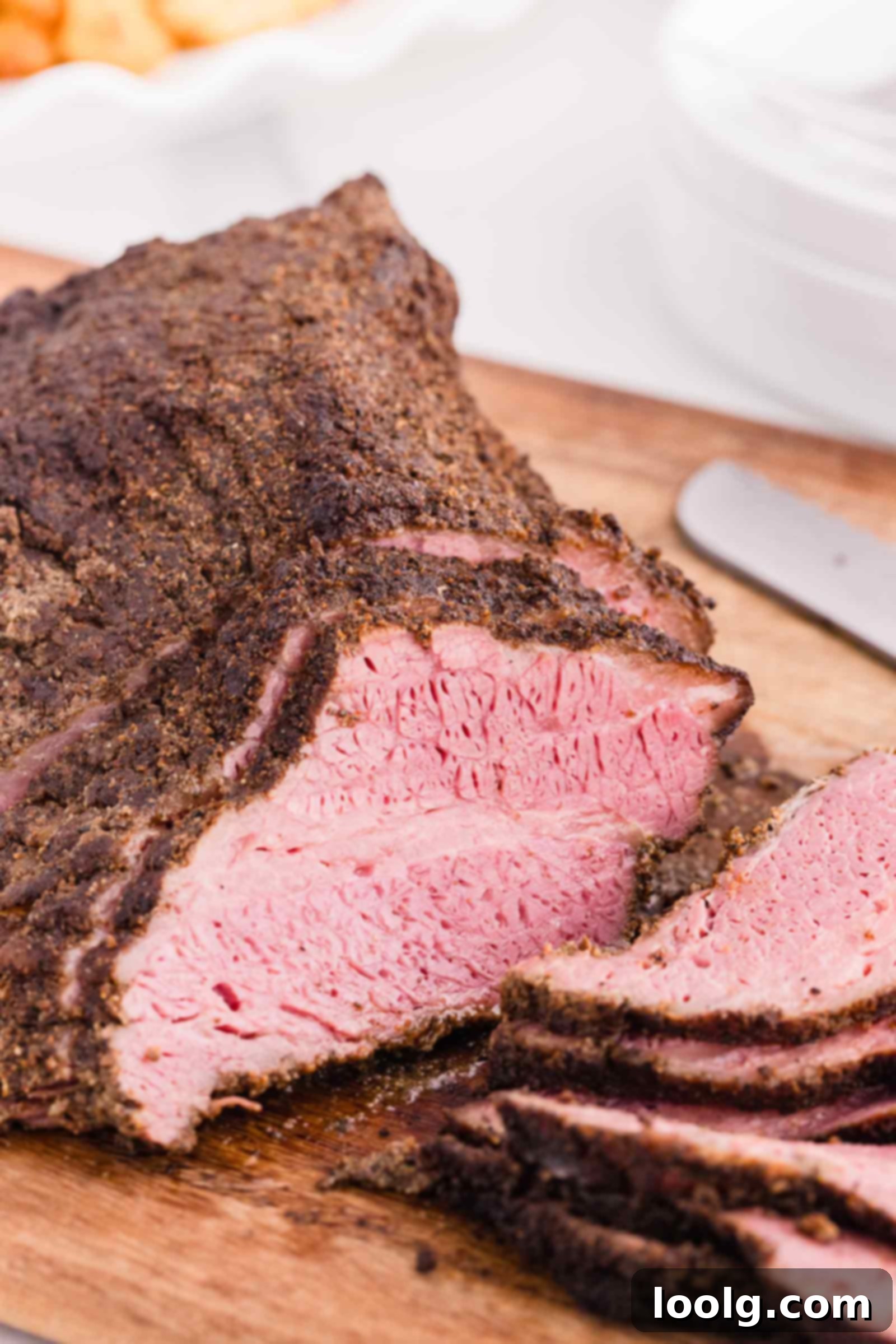
Expert Tips for Reheating Smoked Corned Beef Brisket
Enjoying leftover smoked corned beef brisket is a delight, but reheating it properly is essential to maintain its incredible tenderness and juiciness. Simply zapping it in the microwave can often lead to dry, rubbery meat. Follow these steps for the best reheating results:
- Preheat your oven to a gentle 275 °F (135 °C). This low temperature helps to warm the meat evenly without overcooking or drying it out.
- Place the sliced or whole brisket in a sturdy baking dish or roasting pan. To prevent it from drying out, add a small amount of liquid – about 1/4 cup of beef broth or water – to the bottom of the dish. This creates a moist environment as it reheats.
- Cover the dish tightly with aluminum foil. This traps the steam and moisture, allowing the brisket to warm through gently and stay succulent. Heat for 30–45 minutes, or until the internal temperature of the meat reaches 160°F (71°C).
The recommendation to reheat to 160 °F (71 °C) isn’t primarily about food safety (as the meat was fully cooked initially). Instead, it’s about optimizing the texture, moisture, and overall eating experience. Smoked corned beef brisket contains a good amount of fat and collagen. When reheated to around 150–160 °F, this fat and collagen re-soften and render slightly, making the meat incredibly juicy and tender again. If you only heat it to a lower temperature, say 120–130 °F, the fat and connective tissues won’t fully soften, and the brisket might feel firmer and less tender than desired. A slow, moist reheat ensures your leftovers are just as delicious as the fresh-smoked brisket.
Perfect Pairing: Serving Suggestions for Your Smoked Corned Beef Brisket
- Buttery Cabbage and Potatoes: A timeless and hearty accompaniment that perfectly complements the rich, smoky flavors of the brisket. Consider these Instant Pot Potatoes Colcannon for a traditional Irish flair, or if you prefer a comforting bowl, this Instant Pot Colcannon Soup makes an excellent side. Both recipes include stovetop instructions for your convenience.
- Roasted Root Vegetables: A medley of roasted carrots, parsnips, and sweet potatoes offers a sweet and earthy contrast to the savory brisket. Toss them with herbs and olive oil, then roast until tender and slightly caramelized.
- Creamy Coleslaw: The crispness and tangy dressing of a fresh coleslaw provide a refreshing counterpoint to the rich, tender meat, cutting through the richness beautifully.
- Irish Soda Bread: This traditional, slightly sweet bread is an ideal partner for corned beef, perfect for soaking up juices or making delicious sandwiches. For those avoiding gluten, my absolute favorite is this Gluten-free Soda Bread – it’s incredibly easy to make and boasts a perfect texture.
- Mustard and Pickles: A classic combination! A good quality coarse-grain mustard and some tangy dill pickles add a sharp, piquant contrast that enhances the beef’s flavor.
✨🍪Did you try this smoked corned beef brisket? 🍪✨
Please share your feedback by leaving a ✍️review and 🌟 rating – it helps me and others! I so appreciate it. 💖
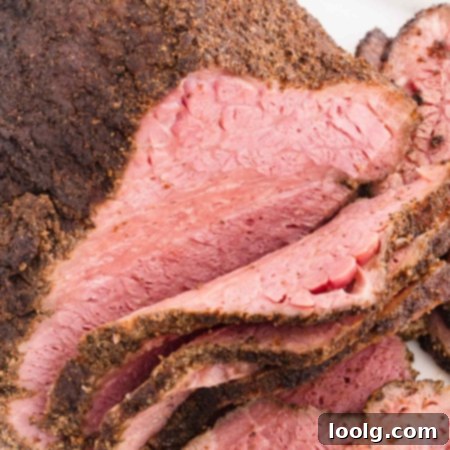
Smoked Corned Beef Brisket
Ingredients
- 4 to 5 pounds (1815-2270) corned beef brisket
More traditional spice rub:
- 2 tablespoons black pepper
- 2 teaspoons garlic powder
- 1 teaspoon onion powder
- 1 teaspoon paprika
- 1 1/2 teaspoons ground coriander seeds optional
- 1 teaspoon ground mustard seeds optional
Original spice rub:
- 2 tablespoons black pepper
- 1 teaspoon garlic powder
- 1 teaspoon onion powder
- 1 teaspoon paprika
- 1/2 teaspoon cayenne
For the smoker:
- wood chips that have been soaked 1 hour before turning on the smoker
Instructions
- If you suspect that store-bought corned beef is typically too salty for your taste, or if this is your very first time preparing smoked corned beef brisket, it is highly recommended to soak the meat to effectively extract some of the excess salt. To begin the soaking process, find a large pot or baking dish that is sufficiently spacious to fully accommodate the brisket. First, rinse the meat thoroughly under cool, running water. Then, place it into the prepared dish or pot. Cover the meat completely with fresh water and allow it to soak for a period of 2 to 3 hours. Critically, remember to exchange the water hourly to ensure continuous salt extraction. For an even less salty result, you can extend this soaking period in the refrigerator for up to 24 hours, still changing the water periodically. Approximately one hour before you anticipate finishing the meat’s soaking time, submerge your chosen wood chips in water to soak, then drain them just before use. Once the meat is nearing the end of its soak, begin preparing your smoker.
- Position a drip pan within your smoker if one is available; this will help catch any drippings and keep your smoker cleaner. Add the thoroughly soaked hickory chips (or your preferred wood) to the smoker. For those using charcoal smokers, simply place the wet wood chips directly on top of the hot coals to begin smoking. If you have an electric smoker, place the chips into its designated wood chip tray or box as per manufacturer instructions.
- While the smoker is actively preheating and reaching its stable temperature, take a small bowl and mix together all the ingredients for your chosen spice rub until well combined.
- Once the soaking period is complete, remove the meat from the water, give it a final quick rinse under running water, and then pat it exceptionally dry with clean paper towels. A dry surface is crucial for the rub to adhere properly and for developing a good “bark.”
- Inspect the brisket for any areas of excessive, hard fat and trim it down as needed. However, be cautious not to remove all the fat. A healthy fat cap (typically about 1/4 to 1/2 inch thick) is vital, as it helps to keep the brisket tender and moist throughout the extended smoking process by slowly rendering and basting the meat.
- Generously rub the prepared seasoning mixture all over the entire surface of the brisket, ensuring it is thoroughly coated. Press the rub gently into the meat to help it adhere.
- Just before you are ready to place the brisket into the smoker, add the drained wood chips (if you haven’t already). Carefully place the seasoned meat on the smoker grate. Allow it to smoke until the internal temperature of the brisket, measured with a reliable meat thermometer inserted into the thickest part, reaches 160 °F (71 °C). This initial smoking phase will typically span 2-3 hours, with the exact duration depending on the specific size and thickness of your brisket.
- Once the brisket reaches 160 °F (71 °C), carefully remove it from the smoker. Tightly wrap the meat in a double layer of heavy-duty aluminum foil. Double-wrapping is important as it provides better insulation and helps prevent any tears or punctures that could lead to liquid leakage. This “Texas Crutch” method will help tenderize the meat further and push it through the stall.
- Return the tightly foil-wrapped brisket to the smoker. Continue to smoke until the internal temperature reaches the desired range of 200-205 °F (93-96 °C). This second cooking phase will typically take another 2-3 hours, again varying with the size of your brisket. The meat should feel incredibly tender when probed with a thermometer or skewer.
- Once the brisket reaches its final temperature, remove it from the smoker and, still wrapped in foil, let it rest on a cutting board or in an insulated cooler. A minimum resting period of 30 minutes is crucial, but ideally, allow it to rest for up to 2 hours. This resting phase allows the meat to reabsorb its juices, ensuring maximum tenderness and moisture when sliced.
- To slice for serving, first, locate the grain of the meat. If your brisket contains both the flat and point, you may want to separate them. Cut the brisket (or sections) in half, then slice across the flat against the grain. Next, turn the point of the brisket 90 degrees and cut it in half, then slice along the point, again ensuring you are slicing directly against the grain. This precise slicing method ensures a wonderfully tender and truly mouth-watering corned beef experience.
- For any delicious leftovers, allow them to cool completely at room temperature before transferring them to an airtight container. Refrigerate for up to 4 days, or freeze for longer storage.
Notes
- Hickory, oak, cherry, apple, pecan, and maple are all excellent wood choices for smoking corned beef brisket, each imparting a unique flavor.
- As with all smoked recipes, it is paramount to cook according to the internal temperature of the meat, not by a fixed time. Times are estimates only.
- If you made this recipe before February 25, 2025, and wish to replicate the exact same flavor profile, select the original spice rub. For a more classic and traditional taste, opt for the traditional spice rub.
